LESSON 25: I am Saving You Money
You have made wonderful progress with your Magic! Here, you are on your twenty-fifth lesson already. I want you to stop at this point and think back on how much you have learned.
First, and above all, you have learned much of the Science of Magic -- that is, the Psychology of Magic, Showmanship, the PRINCIPLES of Magic, of Sleight of Hand. Secondly, more than 60 effects of great variety have been revealed and taught to you so that they are now YOURS.
You realize by now that this is no mere "bag of tricks" you are getting in this Course. I think this is a good time for you to go back again and reread the section on Magic as a Science in Lesson 1. Then thoroughly review the many principles taught you, using the outlines in Lessons 4 and 13. This review of principles every once in a while is absolutely essential to your success. Each time you review, the principles establish themselves more firmly in your mind and become a part of you. And, of course, the more automatic the working of the principles becomes, the better is your presentation of the effects.
Review
LESSONS 13 to 24
I give you here a brief outline to aid you in continuing your review from Lesson 13 to Lesson 24
inclusive.
This time that you spend in reviewing will pay big dividends. You can easily see for yourself how much your performing improves after having gone over your lessons at several different times.
LESSON 13 is an interesting Card Lesson and teaches you the important Principle -- The Regular Pass
LESSON 14 gives you novel effects with cards in combination with fruit. The Principles taught are:
• The Force
• The Jog
• The Thumb Palm
• Mechanical Arrangements explained:
• Handkerchief Card Concealment
• Double Envelope
• False Pip
• Cloth Changing Bag
LESSON 15 -- Effects from the repertoires of two preeminent Magicians, T. Nelson Downs and Percy Abbott of Australia.
Important Principles of Palming and Shifts:
• Right Angle Slip Up Palm • Oblique Slip Up Palm
• Right Angle Kick-In Palm
• Oblique Slip Up Palm Shift
• Index Finger Shift
• Thumb-Little Finger Shift
LESSON 16 -- More of the Magic of Cards with effects from another Great Magician, Ed. Reno, putting
into use Principles you have learned.
LESSON 17 -- Cardini, the wizard of England, reveals some of his famous experiments in this lesson. Principles:
• Edge of Coat Concealment
• Back Hand Palm and Flash Production
• Card Changing in Glass
• Card from Empty Examined Envelope
LESSON 18 -- The remarkable Principles of Rising Cards, known and used by the great men in Magic. Cardini's Rising Card experiment also taught to you.
LESSON 19 -- Original Rising Card Effects from my own repertoire. Beginning of your instruction in
constructive work.
LESSON 20 -- A most valuable lesson discussing important points to help you become a finished artist in Magic:
• How to Please Your Audience
• Keeping Up With the Times
• Making an Impression
• Maintaining a Healthy Attitude Toward Magic
In addition, you learn two interesting effects, one with a wand and one with bands, and Arrangement of Programs
LESSON 21 -- Thorough analysis of the Principles of Sleight of Hand with Coins:
• Thirteen Different Palming Principles
• Eight Coin Holds
• Twelve Manipulative Methods of Vanishing Coins
• How to Dispose of Coins
• Change Over Methods
LESSON 22 -- Coin Classics, involving the use of Sleight of Hand Principles you have learned.
LESSON 23 -- More interesting Coin Effects.
Study your Patter carefully to make your experiments more effective.
LESSON 24 -- Tricks with Eggs, teaching you the handling of eggs. Good opportunity for Comedy Magic here.
Also, you learn how to make my most efficient Egg Bag.
I hope you are giving the best that is in you to Magic so that you may join the ranks of the successful. Do you realize that the famous magicians of the world today are using these same effects, which you learn, on the stage and are making their reputations and success and money with them? You are being equipped to go out and make your start toward fame and fortune. And you have the tremendous advantage of having this Scientific foundation in Magic.
The great Magicians today had to start at the very bottom and strike out blindly to grasp what they could of Magic and hope for the best. But you have done away with years of hardship and failure. You can start ten years ahead of the point where these Magicians started. You can go out with CONFIDENCE and make a success.
LESSON 25
This is a wonderful lesson. You learn new and interesting productions of live rabbits or other small animals. You also learn construction of your apparatus. A knowledge of how to build your own apparatus is absolutely essential to your success, and here you begin with the building of valuable production boxes.
1. I AM SAVING YOU MONEY
Have you ever stopped to think how many, many years of experience and experiment and how many thousands of dollars it has taken to bring the effects in this Course to you? Painstaking analysis and constant simplifying have been done. And now YOU can get the benefits of it with little effort and little money. Big effects which required expensive and massive apparatus you can now perform with ease. I teach you how to master the effects easily and quickly, and I teach you how to build your apparatus at trifling expense.
Professional Magicians of years of experience tell me time and again: "It is marvelous the way you teach effects with such a small cost of production. There is nothing in the whole course that a man cannot build for himself or have built for just a small amount."
It is small wonder that the world's foremost Magicians say this Course would be cheap at $1,000. Many of them spend fabulous sums on one effect alone.
Only recently, Thurston wrote me that he had spent about $10,000 trying to simplify and perfect a certain illusion. Leon told me that he spent $1,000 for the secret of one effect which he is using in his vaudeville acts -- a secret so simple that a schoolboy should know it, yet one which is baffling the finest vaudeville audiences in the country.
Percy Abbott, famous Australian Magician, said to me one day: "It takes a man of experience really to value what you are teaching. If I were to start all over again in Magic as I did years ago and someone were to offer me $10,000 or your Course in Magic, I would take the Course. Knowing what I do today, I say that your Course means a saving of TEN YEARS in working toward success."
So remember — the analysis and simplification of effects which I teach you is SAVING YOU MONEY. None of the value of the effects is lost. In fact, some of the experiments are improved -- yet the construction of the paraphernalia is so simple that you can do it yourself for a very small expenditure.
In today's lesson I teach you the construction of production vanishes, which you can do at home. It is not a bit unusual for Magicians to spend a hundred dollars or more for production vanishes of this kind.
2. EFFECTS WITH RABBITS
The Production and Vanishing of animals is an important part of Magic. The rabbit seems to be the most popular animal for this work. He is easy to handle and the audience always likes to see a rabbit, especially if there are children among the spectators.
In this lesson I teach you how to produce and vanish a rabbit, using apparatus which is simple to make. All you need is a hammer and saw, a paint brush, and some wood. Despite the simplicity of the apparatus, the effects are most mystifying.
Once you learn the principle of construction of the apparatus, you can use it in any size or shape for production and vanishing of other animals. A guinea pig, a couple of doves, a chicken, a duck, a white mouse -- or even three or four rabbits — may be produced and vanished by building the apparatus in accordance with the requirements. Various other articles may be produced and vanished with the same apparatus -- such as an elaborate silk production with various colored Chinese or Japanese silks.
3. THE "MODERN" RABBIT BOX PRODUCTION
This effect is valuable for the production and vanishing of a rabbit. It has also possibilities for the transforming of articles -- such as changing a white rabbit into a black one, etc. A little ingenuity on your part may produce some excellent effects.
This production works well in pantomime. If you have music to accompany you, you can enhance the value of the effect.
However, the experiment permits of good patter. It may be presented, for instance, as a Chinese experiment with a description of the way in which some old Chinese conjurer performed it. It may be performed as Pandora's Box with a production of what she found when she opened the lid of the box. Or it may be presented as Milady's Hope Chest in this way: Ask some lady to make a wish as to what she would like to have appear in the hope chest. Make the request general, merely looking in a certain direction. Several people will probably make wishes, and then will think you meant someone else. Then you can say, "Rather a funny wish — a rabbit's foot; and here you are, four of them," and produce the rabbit from the box. You can get a good comedy effect this way: Say that you are going to build a man's Hope Chest and whatever a man wishes will come into it. Motion to some bald-headed man and say, "Ah, the gentleman wishes for a little hair (hare). Here you are, sir — a little hare." Then produce the rabbit.
Should you care to produce a chicken instead of a rabbit, name the effect, "The Darkey's Dream." The production of a chicken is self-explanatory. If performed before a juvenile audience, the effect may be called, "The Easter Box." Produce some colored Easter eggs, and then finish by producing the rabbit that laid them. Any other original idea which appeals to you can be worked up with this apparatus. Do some original thinking and you will be surprised and pleased at your own ability to create effects on the principles I give you.
The rabbit production which I teach you here is presented as a Chinese story. This makes an excellent stage presentation.
EFFECT:
Performer constructs a small table on the floor or on another table. Then he shows an empty box with no top or bottom. This he places on the table. Next he shows a lid on both sides and places it on the box. In spite of the fact that trickery seems impossible, magician now raises the lid and takes a live, squirming rabbit from the box.
PARAPHERNALIA:
1 -- A special small table with fake removable top.
2 -- A box without top or bottom.
3 -- A lid to fit over box.
4 -- A rabbit.
5 -- A chair and a table.
HOW TO CONSTRUCT THE APPARATUS:
The Base of Table:
Get four boards about a quarter to three-eighths inch thick -- threeply wood is good. Cut down two boards to 12 inches, and two to 14 inches to make the box 12 x 14 inches. Now saw the boards down to 8 inches depth and cut them up three inches to make legs as shown in Figure 1. Then fit the boards tightly together and hinge them inside with good, strong hinges in each corner. Hinges should have removable bolts so that they can be removed and box packed flat. Study Figure 1 carefully.

Special Table Top:
In the table top lies the trick. This must be built to look just like a thin table top and yet faked to conceal a rabbit.
Take another board, 16 inches long x 14 inches wide. Cut a hole in the center, 7-3/4 x 9-3/4 inches. Figure 2 shows you a diagram of the table top with the exact dimensions.
Take a piece of black cloth, large enough to hold a rabbit. Tack it all around the opening of the board to make a bag. Figure 3. Figure 4 shows side view of board with bag in it. This bag should not hang down too low or it will be exposed at bottom of the base of the table.

Now take another thin board, 16 x 14 inches. Cut out the center of this to make an opening 10 x 8 inches. Place this board on top of the board with bag so as to cover tacked edge of cloth. Screw or nail the two boards together. Figure 5.
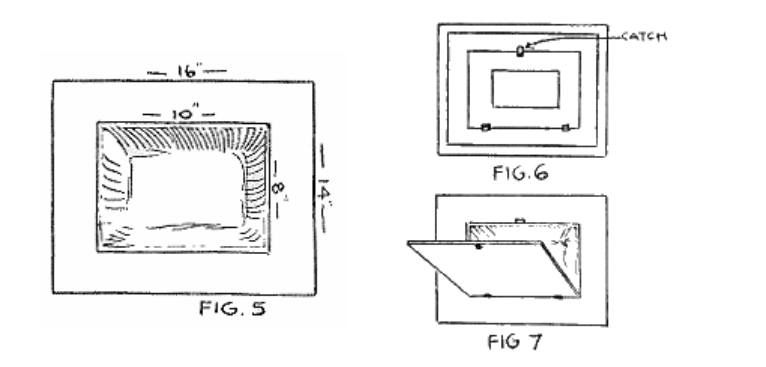
Use thin, three-ply wall or furniture board, as this will not warp. Have each board one solid piece. It is well to take a little pains in constructing this table top, for if you make it well the first time, it will last.
Take a board large enough to fit the opening in the special table top and make a door. Put two hinges on one side and a catch on the other. Have the catch secure and yet one which is easy to open, Figures 6 and 7.
IT IS WELL TO PAINT OR LACQUER THIS TABLE AND TOP. Use Chinese red and stripe or decorate it with black. Figure 6 shows how stripes may be painted around the table top. The strip around the edge of the door should be wide enough to camouflage the hinges and catch of the door.
The table top should look like a thin unprepared board with no suggestion of magical properties.
Therefore the smaller and less visible the hinges and catch can be made, the better. It is wise to sink the hinges and catch into the wood so that they do not protrude at the top of the table.
The Box:
Make a box of thin boards without a bottom or top. Size: 12 inches long x 10 inches wide x 10 inches deep. Paint and decorate the box with stripes as you did the table and table top, Figure 8.
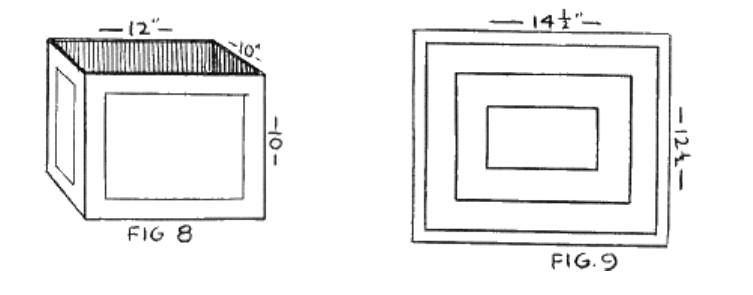
Top for Box:
The top for box is also of thin three-ply wood. Make this top 14-1/2 inches long x 12-1/2 inches wide. Paint and decorate it as you did the table top. It is well to establish a certain color harmony between the four pieces of apparatus -- the base of the table, the special table top, the box, and the box top. It is effective to use Chinese characters or decorations on them, although you may decorate them in any manner you choose, Fig. 9.
SECRET AND PATTER:
To Prepare:
Place rabbit in the bag of the special table top, close down lid, and fix catch. Arrange the four pieces of apparatus on a chair in this manner: Box top against back of chair; Box in front of it on seat of chair; Special table top on the box; Table base on table top. Rabbit, of course, is under the table top inside the box, Figure 10.
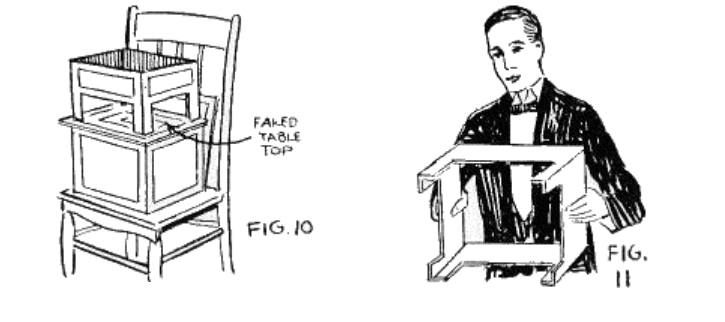
To Perform:
Come forward and start with your Patter.
"Once upon a time, an old Chinese conjurer told me how he used to make certain wishes come true. 'First of all,' he said, 'make a table. Take a table base with a hole in it.'"
Pick up the table base. Show it to audience, turning it all around and on end so that they can see through it. This is to show that nothing is concealed, Figure 11.
Now place the table base on a table, setting it squarely in front of audience so that they can see it plainly, Figure 12.
"Then he told me to place table top on this."
Pickup the table top, grasping it by the end farthest away from the audience. This causes the other end to slant downward and thus conceal the rabbit in the bag under it. Place this top on the table base, putting down the side nearest the audience first, Figures 13 and 14.
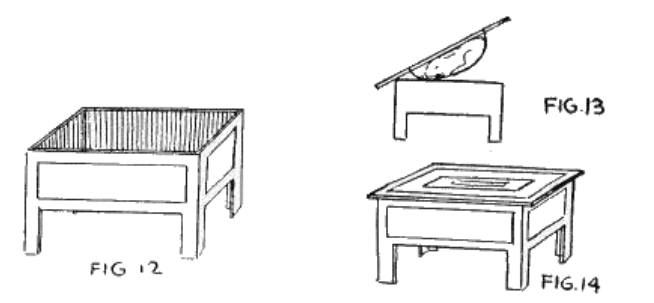
Do this quickly and in a careless manner, as though you just picked up a board and laid it on the table base to make a top. Your MISDIRECTION here is your easy way of handling the special top.
"Now the important part is this magic Chinese Wishing Box."
Pick up the box. Run your right arm through it to show it empty, also hold it up high and move it from side to side so that audience can see through it and is convinced that it is empty.
"This box was built during an early Chinese Dynasty, 935 B. C. — B. C. meaning By Chinaman. By Chee Wu, the grandfather of Ching Poo. In fact, Chee Wu gave me this box himself. 'Now place the box on the table,' said Chee Wu, 'and cover it carefully.'"
Place the box on the table top. Then pick up box top, show it on all sides, and place it on box, Figure 15.
"The lid is on. This is the box that makes wishes come true. Will you make a wish, sir?"
Nod in the direction of someone in the audience, but to no one in particular.
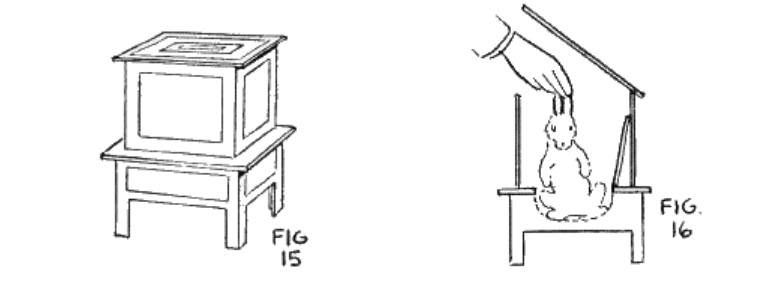
"What a strange wish, sir. The gentleman wishes for a rabbit's foot. No doubt, to keep the evil spirits away."
As you say this, with left hand raise end of lid farthest from audience. With right hand reach into box, open door of table top, grasp rabbit by the ears, and pull him out, Figure 16.
The rabbit is produced, of course, from under the table top, which is under the box. To the audience, however, it appears that you take the rabbit right out of the box. As you produce rabbit, remove top of box entirely, then show rabbit so that all can see, Figure 17.
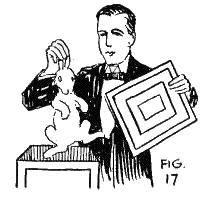
"There you are, sir, not only one rabbit's foot, but four of them."
NOTE: Should you ever desire to use box for a Color Changing Rabbit Production, work it this way: Have a white rabbit in the bag in table top. Have a black rabbit out in full view. Remove box top and reach into box with left hand. Raise door of special table top. Take the white rabbit out of the bag and drop the black one in. Now Produce the white rabbit. Let the door of the table top fall back into place with the catch securing it. It is well to pad the door with felt to prevent its making a loud noise when falling. Then remove the box and show it empty.
If apparatus is large enough, the two rabbits may be placed in the bag at the beginning. Take the black one out first, then pretend to overhear someone saying that they do not want a black rabbit. Use suitable patter here. Then drop black rabbit back into the bag and produce the white one. In this production, lift up the box and show it empty after each color change.
Work quickly! Fumbling ruins your effect. To the audience a second seems as long as a minute if your performance is not snappy.
4. THE "SUCKER" RABBIT BOX VANISH
"Sucker" tricks in Magic are those in which the performer apparently "gives away" the trick. This is done in an exaggerated manner, and the audience is sure that they know how to do it, much to the performer's discomfiture. The magician tries to cover up matters, only to make them worse, until at the finish he proves that the audience is wrong in their conclusions and that he has fooled them after all. You have an example of the "sucker" effect in the last lesson when you use the Egg Bag and pretend to place an egg in your trouser's pocket. These effects are always very popular in Magic.
This "Sucker" Rabbit Vanish is amazing. Juvenile audiences almost go into a riot over it.
EFFECT:
Performer constructs a box with a lid on it. He takes a live rabbit and drops him into the box. Then he makes a magic circle over the box with his hand, removes the lid, and shows the box empty. But suddenly the audience awakes to the fact that there is a false partition in the box and that the rabbit is under that. Magician appears to be embarrassed. After much by-play, he finally raises the partition and opens up the bottom of the box to prove conclusively that the rabbit has vanished.
PARAPHERNALIA:
1 -- Special Top for Box.
2 -- Special Box.
3 -- Rabbit.
HOW TO CONSTRUCT THE APPARATUS:
Special Top:
Follow the directions given you for building the Special Table Top in preceding effect. This special top is constructed in the same way. Size: 141/2 inches long x 13-1/2 inches wide. Door size: 8 x 10 inches, with hinges and catch as in Special Table Top, Figure 18.
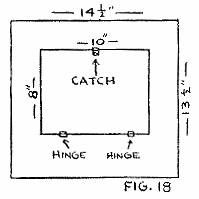
Figure 19, next page, shows bag in this Special Top with door open.
As you see, it looks just like the special table top.
Special Rabbit Box:
Make this box of rather thin wood. Take two boards, each 6 x 10 inches. Place two of the 10-inch sides together and secure them by some kind of catch which can be opened. This forms the bottom of the box, making it 10 x 12 inches. When the box is completed, these two boards act as doors. Now take two boards 12 inches long x 6 inches wide and two others 10 inches long x 6 inches wide. These form the sides of your box. Hinge them all to the bottom, fitting them tight together. Now take another board about 9-1/2 inches x 6 inches. Place this inside the box with a 9-1/2-inch side against a 10-inch end of the box. Hinge this about one inch from the top of the box. Let the other end fall to the bottom of the box and put a small knob on it.
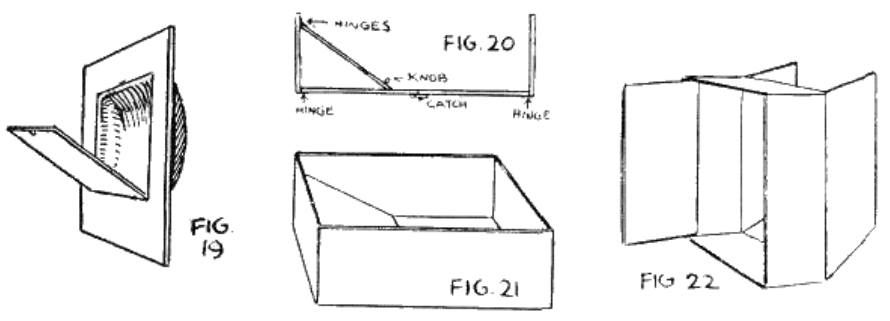
Figure 20 shows a cross section of the box. Notice the catch in the bottom, the hinges on the sides, and the little partition with the hinges and knob inside the box.
Figure 21 shows the box as it looks when completed.
Figure 22 shows the box opened. The catch on the bottom is opened and the two sections open out like doors. The partition is opened outward also with the aid of the knob on it. The audience believes that the rabbit is concealed under this partition.
SECRET AND PATTER:
To prepare:
Have the Special Top lying on the table with the bag underneath, of course. The bag collapses and the top lies flat on the table. Have the Box and Rabbit on table nearby.
To Perform:
Pick up the Rabbit.
"This is quite an extraordinary rabbit. He is an Easter rabbit and lives in Easter-Egg-Land. It is only by special consent that he has come to visit us at this time of the year. I had to assure him that if he would come to visit us I would get him home all right."
Pick up Special Top by rear edge to conceal bag underneath. Place it on Box, putting front edge down first to screen bag, Figure 23.
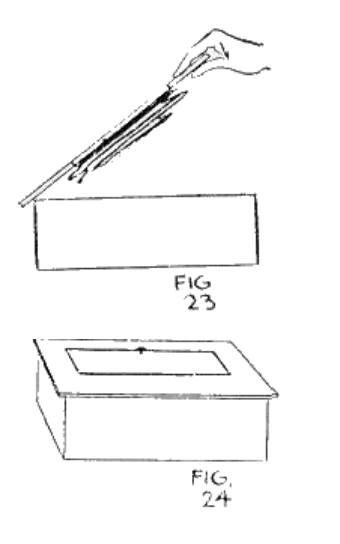
Figure 24, shows box as it appears to audience. To them the lid is just an ordinary board covering the box.
"This is a rabbit house that I had made for Bunny on his official visit. It is here that he lays Easter eggs."
Open door in the Special Top. Hold rabbit up high for a moment, then
place him inside. Rabbit apparently goes into the box, but really goes only into the bag, Figure 25.
Get the rabbit well into the bag. Close door in the Special Top and spring the catch. Figure 26 is a cross section of the box, showing the rabbit in the bag.

Talk to the rabbit inside by bringing your head down near box.
"Are you there all right?"
Pretend the rabbit is answering you. Talk in a subdued ventriloquial voice when answering yourself. Say, "Yes, I'm here all right." Then to audience:
"See, he says that he's all right. What color eggs would you like to have him lay? Blue? Bunny, Bunny, the little girl says she wishes you would lay some blue Easter eggs." Place ear near box as though listening for a reply.
"Did you hear him say anything? That's funny."
Remove top of box. Hold bag side away from audience, of course. Keep eyes on box. Place top on a chair nearby or give it to an assistant. Do this quickly as though you are eager to go on and examine the box, Fig. 27.
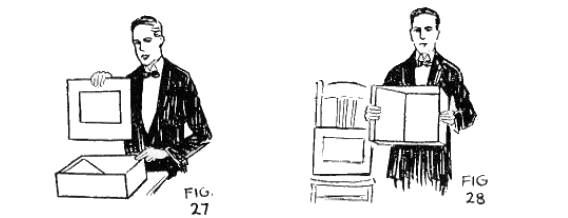
"Why, he's gone."
Pick up box as though it were rather heavy because of the rabbit under the partition. Hold top of box out toward audience. With right hand hold partition down inside box, Figure 28.
"The little girl wanted blue eggs, and I guess he just 'blue' away."
Move right hand farther down on partition. Lift it up a little and then replace as though rabbit were trying to push partition up.
About this time the "show" starts with the youngsters. They think that the rabbit has not vanished at all but is under the slanting door in the box.
"We are all satisfied that the rabbit has vanished."
The children are not satisfied, however, and clamor to see under the door.
"Oh, underneath — Oh, no, the rabbit isn't underneath."
Show bottom of box. As the commotion grows, show various parts of the box, but not under the partition. Finally say:
"Oh, under here. There is nothing there. THAT IS JUST THE FLAT BOTTOM OF THE BOX. So now,
we're all satisfied that he has gone."
Pretend that you are going to put box away. Finally, when the excitement is at a high pitch, say:
"Oh, I forgot I had a special bedroom built for the rabbit, and you think he is in there."
Open up the slanting door, then release catch at bottom of box, allowing bottom doors to open out. "He's nowhere around here. He's back in his home in Easter-Egg-Land."
NOTE: This method of working is presented for use when there are quite a number of children in the audience. It may also be presented as a straight vanish in pantomime style without using Patter at all. This method takes only a few moments.
After you have disposed of top when doing it in pantomime, pretend to hear someone say that rabbit is under slanting door. Shake your head, raise door, and open bottom sections to show box empty.
5. MILADY'S HAT BOX RABBIT VANISH
The effect can be performed with a cardboard box. In spite of the simplicity of the apparatus, it is easy to produce a rabbit, and the production is very effective.
EFFECT:
A cardboard hat box is shown empty. The top is shown on both sides and removed, then rest of box is examined. Top is then replaced. In an instant, Magician opens box again and produces a rabbit from it.
PARAPHERNALIA:
1 -- A heavy cardboard box with lid.
2 -- A black cloth bag to hold rabbit.
3 -- A small rabbit.
HOW TO CONSTRUCT THE APPARATUS:
The Hat Box:
Use a heavy cardboard box, 10 or 12 inches square, with a removable lid, Figure 29.
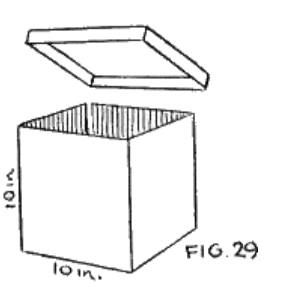
FOR STAGE USE OR CLUB SHOWS it is well to make a box of thin three-ply wood. Paint the outside to resemble a hat box, making it white and striping it with blue, green, or red, or cover it with bright red satin for a pretty effect. Line with green. If you desire, you may make the bottom in two sections hinged to the sides and with a catch so that it can be opened to permit spectators to look through box.
The Rabbit Bag:
This should be made of soft black cloth. Fold over a piece of cloth to make the bag 10 x 7-3/4 inches. Round the bottom corners and stitch around three sides of the bag. Turn the top in to make a hem and run a black draw string through it, knotting the ends. At one end of top sew a hook and at the other an eye as shown in illustration. Near end of draw string at top, sew a heavy black linen thread about 2-1/4 inches long. To the end of the thread tie half of a snap fastener. Use a large fastener, size 3-0 or larger.
Study Figure 30 carefully. It gives you a detailed diagram of the construction of the bag.
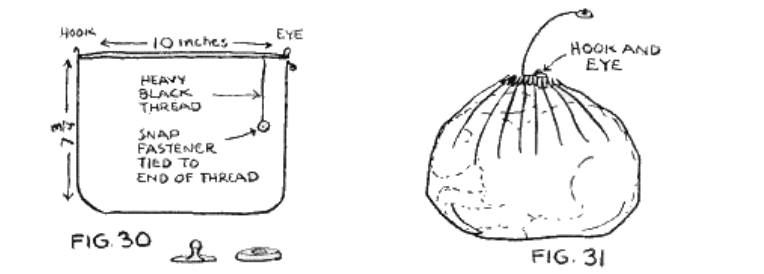
Figure 31 shows how rabbit is placed inside the bag. Draw the draw string tight at the top and hook the hook and eye to hold it secure. Leave the linen thread with fastener outside.
Top of Box:
Sew the other half of snap fastener to inside of one edge of lid. Now snap the fastener on thread to one on box lid. This permits the bag with the rabbit to hang inside of the lid, Figure 32.
Place top of box on box. Bag with rabbit hangs down inside attached to lid by thread and fastener, Fig. 33.

MODUS OPERANDI:
To Prepare:
Have box arranged as in Figure 33 with rabbit and bag to rear. Bring it in and place on table or have assistant hold it.
To Perform:
With left hand at back of lid and right hand at front, raise the lid a little and slide it forward on top of box. Curl your left fingers under lid and hold snap fastener to prevent unloosening, Figure 34.
Raise front part of lid (A) upward to show INSIDE. Audience can see nothing inside of lid. The bag and rabbit hangs inside of box and the snap fastener on edge (B) of lid is not visible, Figure 35.
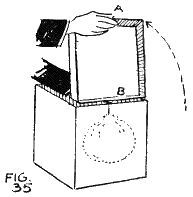
Bring edge (A) down again and let edge (B) come up to show outside of lid to audience, Figure 36, next page.
Bring lid into vertical position and remove completely from box with
left hand. This automatically brings the rabbit bag out of the box to hang down inside and behind the lid. Edges on lid screen it from audience. Hold lid up by edge (B) with left hand and show box empty with right hand, Figure 37.

Set box upright again and place lid on it. First put edge (A) down on box. Then as you gradually put edge (B) down, unsnap the fastener and let the rabbit bag sink gently to bottom of box. Let lid come into position over box without hesitating in the movement so that audience does not suspect anything, Figure 38.
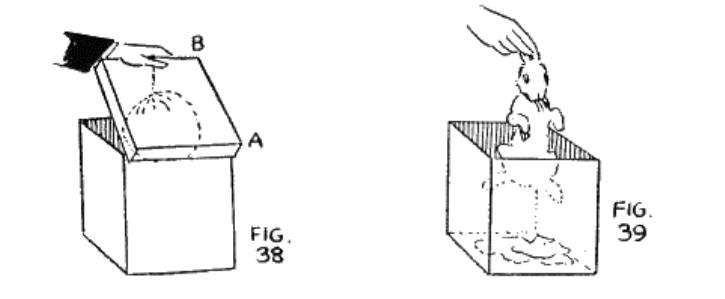
If you have a fan handy, fan the box.
Remove lid and show both sides of it to audience.
Reach inside the box, release the hook and eye, open mouth of bag. Grasp rabbit by the ears and pull him out of the bag and produce him from the box. If rabbit does not slip out easily from bag, use your left hand to help free him. Let the bag remain in the bottom of the box, Figure 39.
NOTE: As in the two preceding rabbit effects, this, too, may be presented with patter.
A bit of originality which I used to use with juvenile audiences is this: I would have a plate of small bits of cotton prepared. Then I would drop them into the box and apparently transform them into a rabbit.
A SUGGESTION: Get a regular size lady's hat box of good quality, such as come from fine milliners. Instead of producing a rabbit, produce a lady's hat. The hat is concealed behind the lid of the box just as the rabbit bag was, attached to a thread and snap fastener. Be careful that hat is small enough to be concealed easily behind the lid.
I performed this effect myself, many times with THREE hat boxes. I showed each one empty and then went from one to another and took out a hat from each. I used three assistants, each holding a box. You may perform the effect, however, placing the boxes on chairs.
Bạn đang đọc truyện trên: TruyenTop.Vip